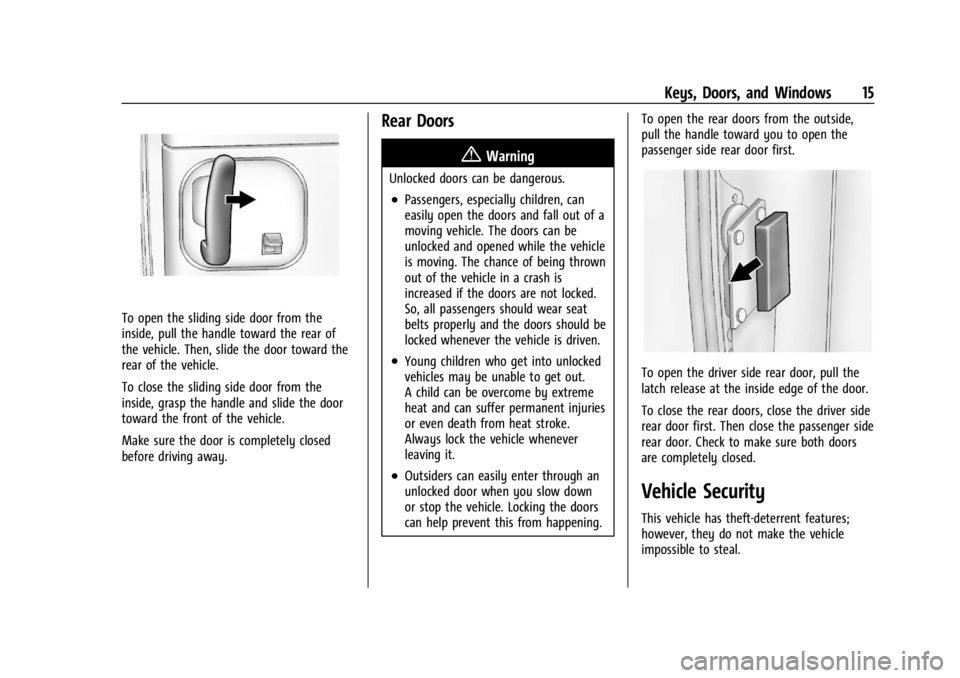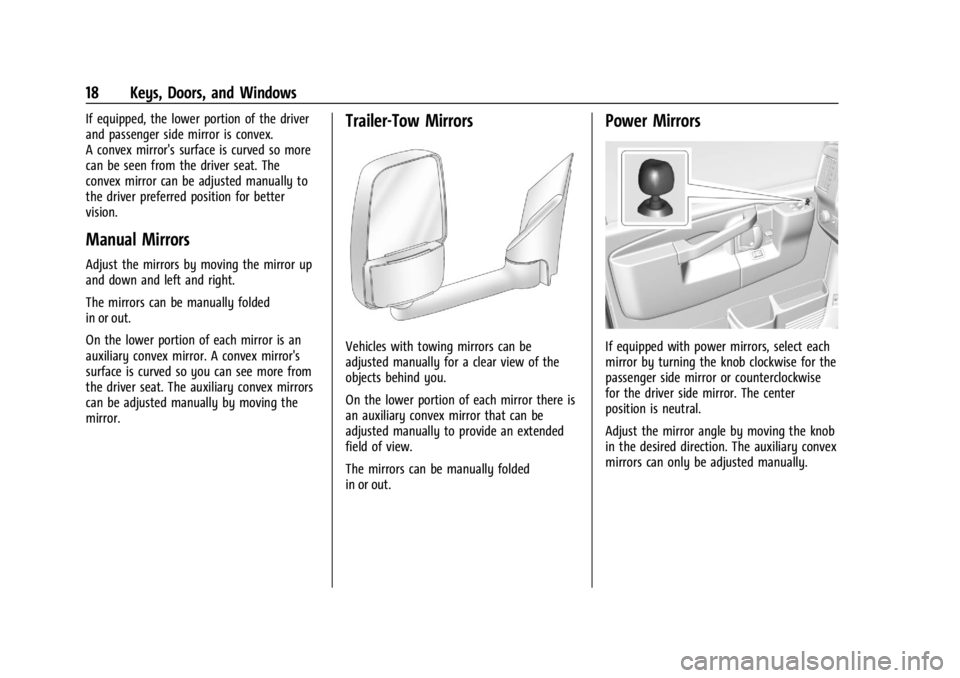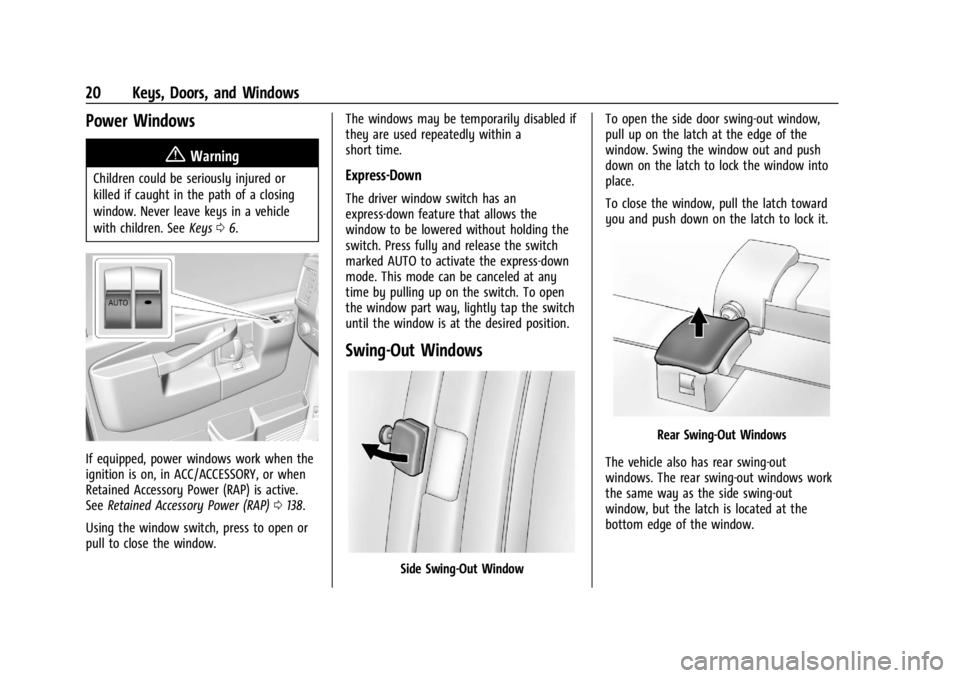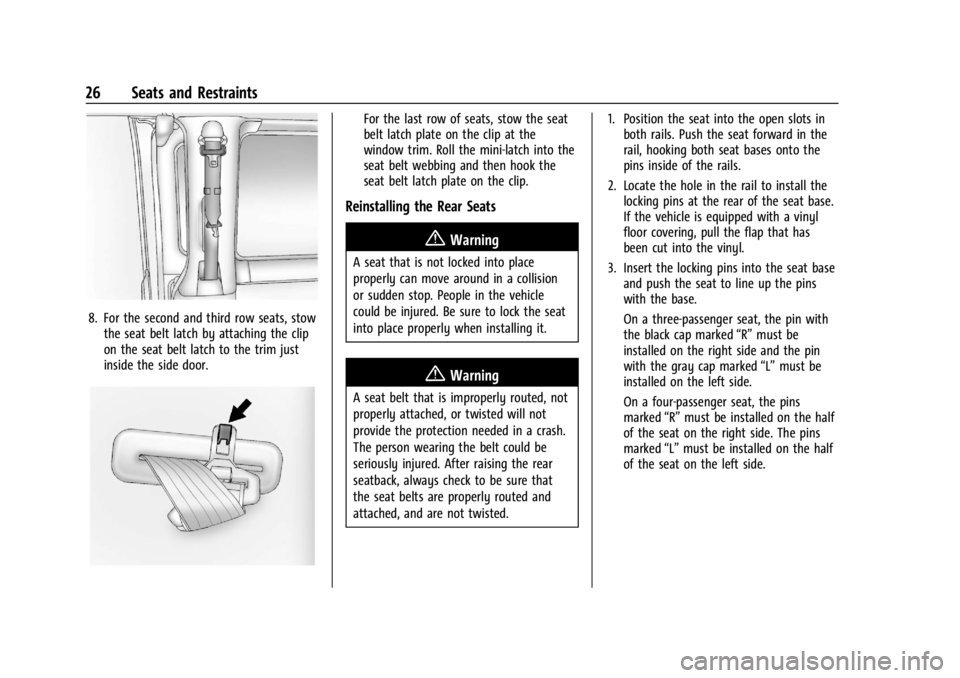tow CHEVROLET EXPRESS CARGO 2021 Owner's Manual
[x] Cancel search | Manufacturer: CHEVROLET, Model Year: 2021, Model line: EXPRESS CARGO, Model: CHEVROLET EXPRESS CARGO 2021Pages: 296, PDF Size: 6.68 MB
Page 6 of 296

Chevrolet Express Owner Manual (GMNA-Localizing-U.S./Canada/Mexico-
14583525) - 2021 - CRC - 1/4/21
Introduction 5
1.Air Vents 0124.
2. Driver Information Center (DIC) Buttons (Out of View). See Driver Information
Center (DIC) 081.
3. Turn Signal Lever. See Turn and
Lane-Change Signals 093.
Windshield Wiper/Washer 067.
4. Horn 067.
5. Hazard Warning Flashers 092.
6. Instrument Cluster 071.
7. Shift Lever. See Automatic Transmission
0 142.
Manual Mode 0144 (If Equipped).
8. Climate Control Systems 0119.
9. Infotainment. See Overview (AM-FM
Radio) 097 or
Overview (Radio with CD/MP3) 099.
10. Power Outlets 069.
11. USB Port (If Equipped). See Auxiliary
Devices 0108. 12. Power Outlet 110/120 Volt Alternating
Current. See Power Outlets 069.
13. Rear Heating System 0121 (If Equipped).
Lane Departure Warning (LDW) 0157 (If
Equipped).
Forward Collision Alert (FCA) System
0 154 (If Equipped).
14. Passenger Airbag On-Off Switch (If Equipped). See Airbag On-Off Switch
0 42.
15. Traction Control/Electronic Stability
Control 0147.
16. Tow/Haul Mode Button (If Equipped). See Tow/Haul Mode 0145.
17. Steering Wheel Controls 066 (If
Equipped).
18. Steering Wheel Adjustment 065 (Out of
View), (If Equipped).
19. Parking Brake Release. See Parking Brake
0 146. 20.
Cruise Control 0149 (If Equipped).
Fast Idle System 0138 (If Equipped).
21. Parking Brake 0146.
22. Data Link Connector (DLC) (Out of View). SeeMalfunction Indicator Lamp (Check
Engine Light) 076.
23. Instrument Panel Illumination Control
093.
Dome Lamp Override. See Dome Lamps
0 94.
24. Exterior Lamp Controls 090.
Page 7 of 296

Chevrolet Express Owner Manual (GMNA-Localizing-U.S./Canada/Mexico-
14583525) - 2021 - CRC - 12/9/20
6 Keys, Doors, and Windows
Keys, Doors, and
Windows
Keys and Locks
Keys . . . . . . . . . . . . . . . . . . . . . . . . . . . . . . . . . . . . . 6
Remote Keyless Entry (RKE) System . . . . . 8
Remote Keyless Entry (RKE) SystemOperation . . . . . . . . . . . . . . . . . . . . . . . . . . . . . . 8
Remote Vehicle Start . . . . . . . . . . . . . . . . . . . 10
Door Locks . . . . . . . . . . . . . . . . . . . . . . . . . . . . . . 11
Power Door Locks . . . . . . . . . . . . . . . . . . . . . . . 11
Cargo Door Relocking . . . . . . . . . . . . . . . . . . . 11
Delayed Locking . . . . . . . . . . . . . . . . . . . . . . . . 12
Automatic Door Locks . . . . . . . . . . . . . . . . . . . 12
Lockout Protection . . . . . . . . . . . . . . . . . . . . . . 12
Safety Locks . . . . . . . . . . . . . . . . . . . . . . . . . . . . 12
Safety Locks . . . . . . . . . . . . . . . . . . . . . . . . . . . . 12
Doors
Side Door (60/40 Swing-Out) . . . . . . . . . . . 13
Sliding Door . . . . . . . . . . . . . . . . . . . . . . . . . . . . 14
Rear Doors . . . . . . . . . . . . . . . . . . . . . . . . . . . . . . 15
Vehicle Security
Vehicle Security . . . . . . . . . . . . . . . . . . . . . . . . . 15
Vehicle Alarm System . . . . . . . . . . . . . . . . . . 16
Immobilizer . . . . . . . . . . . . . . . . . . . . . . . . . . . . . 16
Immobilizer Operation . . . . . . . . . . . . . . . . . . 17
Exterior Mirrors
Convex Mirrors . . . . . . . . . . . . . . . . . . . . . . . . . 17
Manual Mirrors . . . . . . . . . . . . . . . . . . . . . . . . . 18
Trailer-Tow Mirrors . . . . . . . . . . . . . . . . . . . . . 18
Power Mirrors . . . . . . . . . . . . . . . . . . . . . . . . . . 18
Folding Mirrors . . . . . . . . . . . . . . . . . . . . . . . . . 19
Heated Mirrors . . . . . . . . . . . . . . . . . . . . . . . . . 19
Interior Mirrors
Interior Rearview Mirrors . . . . . . . . . . . . . . . 19
Manual Rearview Mirror . . . . . . . . . . . . . . . . 19
Windows
Windows . . . . . . . . . . . . . . . . . . . . . . . . . . . . . . . 19
Manual Windows . . . . . . . . . . . . . . . . . . . . . . . 19
Power Windows . . . . . . . . . . . . . . . . . . . . . . . . 20
Swing-Out Windows . . . . . . . . . . . . . . . . . . . . 20
Enhanced Technology Glass . . . . . . . . . . . . . 21
Rear Windows . . . . . . . . . . . . . . . . . . . . . . . . . . 21
Sun Visors . . . . . . . . . . . . . . . . . . . . . . . . . . . . . . 21
Keys and Locks
Keys
{Warning
Leaving children in a vehicle with the
ignition key is dangerous and children or
others could be seriously injured or killed.
They could operate the power windows
or other controls or make the vehicle
move. The windows will function with
the keys in the ignition, and children or
others could be caught in the path of a
closing window. Do not leave children in
a vehicle with the ignition key.
Page 15 of 296

Chevrolet Express Owner Manual (GMNA-Localizing-U.S./Canada/Mexico-
14583525) - 2021 - CRC - 12/9/20
14 Keys, Doors, and Windows
To open the front portion of a 60/40 door
from the inside, pull the handle toward you
and push the door open.
To open the rear portion of a 60/40 door
from the outside, pull the handle on the
side of the rear door and pull the door
toward you.
To close the 60/40 side doors, close the rear
door first. Then close the front door. Check
to make sure that both doors are
completely closed.
The swing-out doors have a check strap
assembly in the door frame to keep the
door from opening beyond 90 degrees.
To open the door beyond 90 degrees, close
the door partially, pull the check strap
toward you and then open the door. When
the door is closed, the check strap will
automatically re-engage.Sliding Door
To open the sliding side door from the
outside, pull the handle toward the rear of
the vehicle and slide the door open.
To close the sliding side door from the
outside, use the handle to slide the door
toward the front of the vehicle.
When the door is closed, it will be flush with
the side of the body.
Page 16 of 296

Chevrolet Express Owner Manual (GMNA-Localizing-U.S./Canada/Mexico-
14583525) - 2021 - CRC - 12/9/20
Keys, Doors, and Windows 15
To open the sliding side door from the
inside, pull the handle toward the rear of
the vehicle. Then, slide the door toward the
rear of the vehicle.
To close the sliding side door from the
inside, grasp the handle and slide the door
toward the front of the vehicle.
Make sure the door is completely closed
before driving away.
Rear Doors
{Warning
Unlocked doors can be dangerous.
.Passengers, especially children, can
easily open the doors and fall out of a
moving vehicle. The doors can be
unlocked and opened while the vehicle
is moving. The chance of being thrown
out of the vehicle in a crash is
increased if the doors are not locked.
So, all passengers should wear seat
belts properly and the doors should be
locked whenever the vehicle is driven.
.Young children who get into unlocked
vehicles may be unable to get out.
A child can be overcome by extreme
heat and can suffer permanent injuries
or even death from heat stroke.
Always lock the vehicle whenever
leaving it.
.Outsiders can easily enter through an
unlocked door when you slow down
or stop the vehicle. Locking the doors
can help prevent this from happening.To open the rear doors from the outside,
pull the handle toward you to open the
passenger side rear door first.
To open the driver side rear door, pull the
latch release at the inside edge of the door.
To close the rear doors, close the driver side
rear door first. Then close the passenger side
rear door. Check to make sure both doors
are completely closed.
Vehicle Security
This vehicle has theft-deterrent features;
however, they do not make the vehicle
impossible to steal.
Page 19 of 296

Chevrolet Express Owner Manual (GMNA-Localizing-U.S./Canada/Mexico-
14583525) - 2021 - CRC - 12/9/20
18 Keys, Doors, and Windows
If equipped, the lower portion of the driver
and passenger side mirror is convex.
A convex mirror's surface is curved so more
can be seen from the driver seat. The
convex mirror can be adjusted manually to
the driver preferred position for better
vision.
Manual Mirrors
Adjust the mirrors by moving the mirror up
and down and left and right.
The mirrors can be manually folded
in or out.
On the lower portion of each mirror is an
auxiliary convex mirror. A convex mirror's
surface is curved so you can see more from
the driver seat. The auxiliary convex mirrors
can be adjusted manually by moving the
mirror.
Trailer-Tow Mirrors
Vehicles with towing mirrors can be
adjusted manually for a clear view of the
objects behind you.
On the lower portion of each mirror there is
an auxiliary convex mirror that can be
adjusted manually to provide an extended
field of view.
The mirrors can be manually folded
in or out.
Power Mirrors
If equipped with power mirrors, select each
mirror by turning the knob clockwise for the
passenger side mirror or counterclockwise
for the driver side mirror. The center
position is neutral.
Adjust the mirror angle by moving the knob
in the desired direction. The auxiliary convex
mirrors can only be adjusted manually.
Page 20 of 296

Chevrolet Express Owner Manual (GMNA-Localizing-U.S./Canada/Mexico-
14583525) - 2021 - CRC - 12/9/20
Keys, Doors, and Windows 19
Folding Mirrors
Manual Folding Mirrors
The mirrors can be folded inward toward
the vehicle to prevent damage when going
through an automatic car wash. Push the
mirror outward to return it to the original
position.
Side Blind Zone Alert
The vehicle may have Side Blind Zone Alert.
SeeSide Blind Zone Alert (SBZA) 0155.
Heated Mirrors
For vehicles with heated mirrors:
1:Press to heat the mirrors.
An indicator light in the button lights when
the outside heated mirrors are activated.
See “Rear Window Defogger” underClimate
Control Systems 0119.
Interior Mirrors
Interior Rearview Mirrors
Adjust the rearview mirror for a clear view
of the area behind the vehicle. Do not spray glass cleaner directly on the
mirror. Use a soft towel dampened with
water.
Manual Rearview Mirror
Push the tab forward for daytime use and
pull it rearward for nighttime use to avoid
glare of the headlamps from behind.
Backup Video Manual Mirror
If equipped, this manual dimming mirror
provides a camera view of the area behind
the vehicle. The video display feature comes
on when the vehicle is shifted in R (Reverse),
and turns off when the vehicle is shifted out
of R (Reverse).
Troubleshooting
If the vehicle is in R (Reverse) and a blue
screen is displayed in the mirror and then
the display shuts off, see your dealer for
service.
See
Rear Vision Camera (RVC) 0152.
Windows
{
Warning
Never leave a child, a helpless adult, or a
pet alone in a vehicle, especially with the
windows closed in warm or hot weather.
They can be overcome by the extreme
heat and suffer permanent injuries or
even death from heat stroke.
Manual Windows
Operate the manual windows by turning the
hand crank on each door to raise or lower
the side door windows.
Page 21 of 296

Chevrolet Express Owner Manual (GMNA-Localizing-U.S./Canada/Mexico-
14583525) - 2021 - CRC - 12/9/20
20 Keys, Doors, and Windows
Power Windows
{Warning
Children could be seriously injured or
killed if caught in the path of a closing
window. Never leave keys in a vehicle
with children. SeeKeys06.
If equipped, power windows work when the
ignition is on, in ACC/ACCESSORY, or when
Retained Accessory Power (RAP) is active.
See Retained Accessory Power (RAP) 0138.
Using the window switch, press to open or
pull to close the window. The windows may be temporarily disabled if
they are used repeatedly within a
short time.
Express-Down
The driver window switch has an
express-down feature that allows the
window to be lowered without holding the
switch. Press fully and release the switch
marked AUTO to activate the express-down
mode. This mode can be canceled at any
time by pulling up on the switch. To open
the window part way, lightly tap the switch
until the window is at the desired position.
Swing-Out Windows
Side Swing-Out WindowTo open the side door swing-out window,
pull up on the latch at the edge of the
window. Swing the window out and push
down on the latch to lock the window into
place.
To close the window, pull the latch toward
you and push down on the latch to lock it.
Rear Swing‐Out Windows
The vehicle also has rear swing‐out
windows. The rear swing-out windows work
the same way as the side swing‐out
window, but the latch is located at the
bottom edge of the window.
Page 27 of 296

Chevrolet Express Owner Manual (GMNA-Localizing-U.S./Canada/Mexico-
14583525) - 2021 - CRC - 12/9/20
26 Seats and Restraints
8. For the second and third row seats, stowthe seat belt latch by attaching the clip
on the seat belt latch to the trim just
inside the side door.
For the last row of seats, stow the seat
belt latch plate on the clip at the
window trim. Roll the mini-latch into the
seat belt webbing and then hook the
seat belt latch plate on the clip.
Reinstalling the Rear Seats
{Warning
A seat that is not locked into place
properly can move around in a collision
or sudden stop. People in the vehicle
could be injured. Be sure to lock the seat
into place properly when installing it.
{Warning
A seat belt that is improperly routed, not
properly attached, or twisted will not
provide the protection needed in a crash.
The person wearing the belt could be
seriously injured. After raising the rear
seatback, always check to be sure that
the seat belts are properly routed and
attached, and are not twisted. 1. Position the seat into the open slots in
both rails. Push the seat forward in the
rail, hooking both seat bases onto the
pins inside of the rails.
2. Locate the hole in the rail to install the locking pins at the rear of the seat base.
If the vehicle is equipped with a vinyl
floor covering, pull the flap that has
been cut into the vinyl.
3. Insert the locking pins into the seat base and push the seat to line up the pins
with the base.
On a three-passenger seat, the pin with
the black cap marked “R”must be
installed on the right side and the pin
with the gray cap marked “L”must be
installed on the left side.
On a four-passenger seat, the pins
marked “R”must be installed on the half
of the seat on the right side. The pins
marked “L”must be installed on the half
of the seat on the left side.
Page 32 of 296

Chevrolet Express Owner Manual (GMNA-Localizing-U.S./Canada/Mexico-
14583525) - 2021 - CRC - 12/9/20
Seats and Restraints 31
Lap-Shoulder Belt
All seating positions in the vehicle have a
lap-shoulder belt. If you are using a rear
seating position with a detachable seat belt
and the seat belt is not attached, see
“Reinstalling the Rear Seats”underRear
Seats 024 for instructions on reconnecting
the seat belt to the mini-buckle.
The following instructions explain how to
wear a lap-shoulder belt properly.
1. Adjust the seat, if the seat is adjustable, so you can sit up straight. To see how,
see “Seats” in the Index.
2. Pick up the latch plate and pull the belt across you. Do not let it get twisted.
The lap-shoulder belt may lock if you
pull the belt across you very quickly.
If this happens, let the belt go back
slightly to unlock it. Then pull the belt
across you more slowly.
If the shoulder portion of a passenger
belt is pulled out all the way, the child
restraint locking feature may be
engaged. See Child Restraint Systems
0 49. If this occurs, let the belt go back
all the way and start again. If the
locking feature stays engaged after
letting the belt go back to stowed position on the seat, move the seat
rearward or recline the seat until the
shoulder belt retractor lock releases.
3. Push the latch plate into the buckle until
it clicks.
Pull up on the latch plate to make sure
it is secure. If the belt is not long
enough, see Seat Belt Extender 035.
Position the release button on the buckle
so that the seat belt could be quickly
unbuckled if necessary.
4. If equipped with a shoulder belt height adjuster, move it to the height that is
right for you. See “Seat belt Height Adjuster”
later in this section for
instructions on use and important safety
information.5. To make the lap part tight, pull up on the shoulder belt.
It may be necessary to pull stitching on
the seat belt through the latch plate to
fully tighten the lap belt on smaller
occupants.
Page 33 of 296

Chevrolet Express Owner Manual (GMNA-Localizing-U.S./Canada/Mexico-
14583525) - 2021 - CRC - 12/9/20
32 Seats and Restraints
To unlatch the belt, push the button on the
buckle. The belt should return to its stowed
position. Slide the latch plate up the seat
belt webbing when the seat belt is not in
use. The latch plate should rest on the
stitching on the seat belt, near the guide
loop on the side wall.
Always stow the seat belt slowly. If the seat
belt webbing returns quickly to the stowed
position, the retractor may lock and cannot
be pulled out. If this happens, pull the seat
belt straight out firmly to unlock the
webbing, and then release it. If the webbing
is still locked in the retractor, see your
dealer.Before a door is closed, be sure the seat belt
is out of the way. If a door is slammed
against a seat belt, damage can occur to
both the seat belt and the vehicle.
Seat Belt Height Adjuster
The vehicle has a seat belt height adjuster
for the driver and front outboard passenger
positions.
Adjust the height so the shoulder portion of
the belt is on the shoulder and not falling
off of it. The belt should be close to, but not
contacting, the neck. Improper shoulder belt
height adjustment could reduce the
effectiveness of the seat belt in a crash. See
How to Wear Seat Belts Properly
029.
Squeeze both sides of the release button
and pull outward. Then move the height
adjuster up or down to the desired position
and release the button.
After the adjuster is set to the desired
position, try to move it up or down without
squeezing the release button to make sure it
has locked into position.
Seat Belt Pretensioners
If the vehicle has seat-mounted side impact
airbags and roof-rail airbags, it also has seat
belt pretensioners for the front outboard
occupants.
Although the seat belt pretensioners cannot
be seen, they are part of the seat belt
assembly. They can help tighten the seat
belts during the early stages of a moderate
to severe frontal, near frontal, or rear crash
if the threshold conditions for pretensioner
activation are met. And, if the vehicle has
roof-rail airbags, seat belt pretensioners can
help tighten the seat belts in a side crash or
a rollover event.